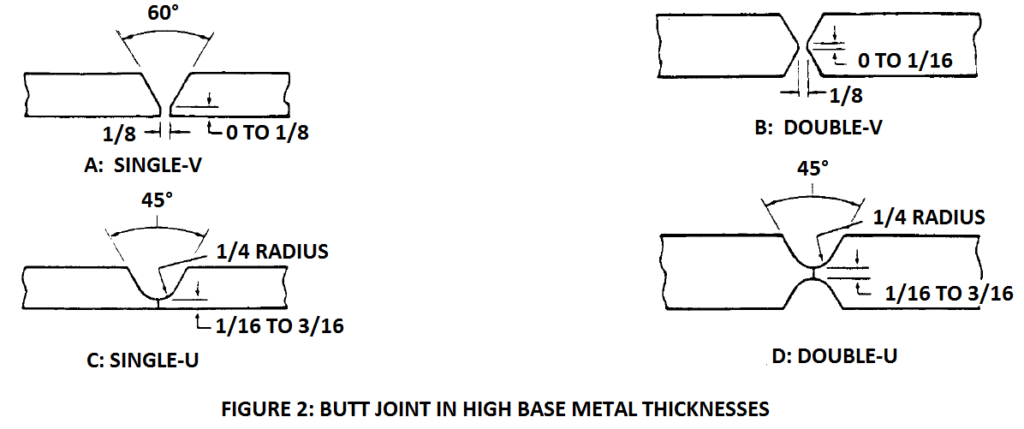In welding, butt joints are used to join the edges of two plates or surfaces located in approximately the same plane. Butt joint is the most commonly used in the industry among all joint types.
The following figure shows plain square butt joints of various thicknesses. As can be seen, there is no beveling of the two parts in these thicknesses. Such low thickness base metals can be joined without any edge preparation.

The following figure shows butt joints in higher thicknesses. As can be seen, as the thickness increases, beveling of the two edges becomes necessary to obtain a good weld. This edge preparation can be done in several designs, such as U-groove, V-groove, J-groove, and so on. Different groove designs are suited for different thicknesses.

The edges shown in the above figure 2 above can be prepared using several techniques, such as flame cutting, shearing, flame grooving, machining, chipping, or carbon arc air cutting or gouging.
Before welding, a fit up needs to be made. This means that the two parts should be aligned with a uniform root gap throughout the weld length, and the assembly should be tack welded, so that it remains in place during welding. During fit-up of plates, a pre-setting of the plates can be done to off-set the welding distortion that would occur as a result of welding.
A good fit-up contributes to the final quality of the weld. Before commencing the welding, the welder must ensure that the surface of both parts is clean. The surface should be free from dust, oxides, oil, grease, or any other contaminants.
What Groove-Design Is Good For What Thickness?
Refer the figures1 and 2 above, again.
When the base metal thickness varies between 1/32 inch to 3/16 inch (0.8 mm to 4.8 mm), no edge preparation is generally necessary. Welding can be done with a plain square type of edge preparation, as shown in figure 1.
When the base metal thickness varies from 3/8 inch to ½ inch (9.5 mm to 13 mm), a single-V or single-U (as shown in ‘A’ and ‘C’ of figure 2 above) is the recommended groove design.
When still higher thicknesses are involved, double sided edge preparation is recommended. For example, when the base metal thickness is more thanhalf an inch (13 mm and higher), a double-V groove design (as illustrated in ‘C’ of figure 2) can be used. For high thicknesses [3/4 inches (19 mm) and higher], double U-groove is the recommended groove design.
Double sides welds are advantageous in several ways. For one, full penetration is possible to achieve in such welds. Also, less amount of weld metal is expended in double sided welds, in comparison with double sided welds. Further, distortion can also be minimized when welding from both side is possible.
So, whenever the application demands a weld of high strength and high radiographic quality, double sided edge preparation is the preferred groove-design.
This was a small introduction to welding of butt joints. Please share your thoughts in the comments section below.
